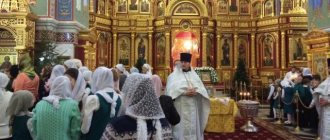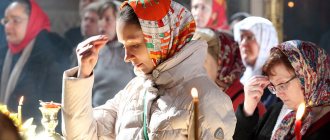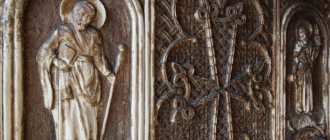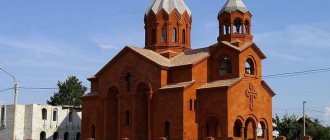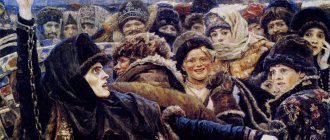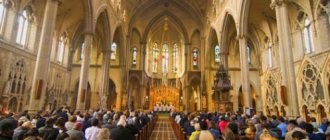"Save me, God!".
Thank you for visiting our website, before you start studying the information, please subscribe to our Orthodox community on Instagram, Lord, Save and Preserve † - https://www.instagram.com/spasi.gospodi/. The community has more than 60,000 subscribers. There are many of us like-minded people and we are growing quickly, we post prayers, sayings of saints, prayer requests, and timely post useful information about holidays and Orthodox events... Subscribe. Guardian Angel to you!
The question often arises: are Armenians Catholics or Orthodox? The Armenian Apostolic Church is considered to be the main one in Armenia. Accordingly, those who are parishioners of this church are considered Orthodox. But there is also a movement that separated from the main church and formed the Armenian Catholic Church.
Orthodox or not
The main and official religion of this nationality at the moment is Christianity, but it has certain differences here from the Russian Church. The difference is noticeable both in comparison with Catholics and with other directions of this church. Why this happened and what the specifics of their religion lie can only be considered within the political and historical events that in this country occurred simply at an alarming speed and intensely influenced the population.
Christianity by confession accounts for more than 94% of the population. And this is about 2,950,000 thousand people.
The religions of the rest of the population can be distinguished here - Islam, Catholicism, Judaism, Yazidism and some other religions. In this, this Caucasian republic is similar to its Georgian neighbors.
Christianity
Christianity here has its own distinctive features. Therefore, if we express the features and differences of their confession, they are as follows:
- In the person of Jesus Christ, the supremacy of one omnipotent power is recognized, which has a single hypostasis and nature.
- The Gregorian Apostolic Church in Armenia indicates that the divine power and might of Jesus Christ absorbed his human nature. Individual opinions of church representatives that Jesus Christ has flesh are ignored. Thus, the body of Christ is endowed with the qualities of ether, incorruptibility and impassibility.
- In the Caucasian Republic, prosphora mixed with unleavened dough is used during services, in contrast to the Orthodox, which uses leaven.
- When making the sign of the cross, Armenians also do this with their right hand. But they take a different movement - the hand first goes to the left, and then to the right. Catholics perform a similar movement. But among Christians, it is customary to make the sign of the sign by moving the hand first to the right, then to the left.
- Considering the hierarchy of this church, it is worth noting that there are 5 highest spiritual orders, of which the highest is the title of Catholicos. And if we compare it with Orthodoxy, then there are only 3 church degrees.
- If we evaluate the degree of restrictions that are imposed during Lent, then despite the 70-day period of abstinence from excesses before the Easter holiday, on Pentecost, Armenians are allowed to eat eggs and cheese. But this applies exclusively to Sundays.
Despite the fact that all Armenian churches are led by the Catholicos, the name of this religious order does not have any similarities with Catholicism. The head of the Apostolic Church is the highest conciliar primate, whose religious authority extends not only to the inhabitants of the state, but also to those ethnic groups that are located in different states of the world. After all, Armenians are one of the most divided nationalities in the world.
Yandex pictures
But Armenian Christians differ not only from the Orthodox, Georgian, but also from other churches that profess this religion. The following features can be highlighted:
- Divine services are conducted on the Grabar, which belongs to the ancient Armenian dialect.
- The service is accompanied by organ music.
- The walls of temples and churches have distinctive decorations from Christians and Catholics.
- The Armenian faith allows not to offer prayers in front of icons. This is probably why there are practically none of them in churches or they are represented in small numbers.
But from the general point we can highlight such a moment as the time of the service. In the vast majority of cases, Christian holidays among Armenians coincide with Catholic ones in terms of dates. This happens because both churches use the Gregorian calendar.
But if we evaluate how Christianity arose, then it is very important to consider the history of this state. After all, if you count how many millennia this people has existed, at different periods there was the adoption of one religion, then another. But now, in the vast majority of cases, Armenians believe in Jesus Christ. Let us consider briefly, but in as much detail as possible, how and when this ancient people accepted this faith and how many centuries it has existed on the territory of this state.
Here are the milestones that can be identified in Christianity in Armenia:
- This faith arose on the territory of the ancient state of Armenia, starting around the 2nd century AD.
- It became state-owned in 301 AD.
- It is apostolic in name due to the fact that 2 of the apostles of Jesus Christ - Thaddeus and Bartholomew - after the death and resurrection of their teacher, came to the territory of ancient Armenia in order to spread the Christian faith and began to preach there. This is how the first Christian communities were formed.
- But, despite the fact that this religion quickly took root in Armenia, the first steps were quite difficult. Thus, the Apostle Bartholomew was crucified for preaching, and Thaddeus continued for some time to spread this faith in the territory of ancient Armenia.
But in ancient times, before the adoption of Christianity, these people, like the vast majority of other ethnic groups, were pagans. Thanks to a developed culture, including writing, gods and ways of worshiping them are quite well documented on the territory of this state. The chronicles were compiled not only by Armenians, but there are also historical testimonies from Greek and Roman authors. Most often, historians and ethnographers draw certain parallels between the pantheon of Armenian and Greek gods. But after the Christian faith took root among the Armenians, the pagan religion was almost completely supplanted.
If we estimate the founding date of this Church, then it is considered to be 303. This is the date of construction of the Etchmiadzin Cathedral, in which the Supreme Patriarch and Catholicos began to arrive. The cathedral also became a religious center, and a little later a place of pilgrimage for all Armenian Christians.
Yandex pictures
How the pagan religion was replaced by the Christian faith of this people becomes more understandable if we consider that, like any other structural change, this did not happen without some persecution and bloodshed. Thus, Gregory the Illuminator sat in a pit for 14 years because he refused to worship the pagan gods.
But even after Christianity became the official religion in the territory of this country, not everything moved smoothly from the point of view of religion. The Persians and Arabs intensified their persecution of Christians. This situation was observed until the end of the 4th and beginning of the 5th centuries. During this period, tens of thousands of followers of Christianity were killed and died as martyrs. But it cannot be said that the heads of Christians were placed on the altar absolutely without resistance. So in 451 the Battle of Arava took place, which is a striking example of how Christians defended their right to worship. And, although this people lost in the confrontation with the Persians in this military battle, since the opposing sides had unequal forces, Christianity still managed to survive. And already by 484, after 30 years of active confrontation, the Treaty of Nvarsak was signed - according to this agreement, this ethnic group received the right to free religion and Christianity became their predominant religion.
If we draw parallels between the Christian Orthodox, Armenian and Catholic churches, then each of them is distinguished by its specific aspects. And despite the fact that there is much in common between Orthodox and Christians in this country, Catholicism has had a significant influence on the Apostolic Church of Armenia. Therefore, the Armenian Church and Orthodoxy have much in common.
Historical places associated with the adoption of Christianity in Armenia
Much of the above took place in what is now Armenian . Those interested can visit the sites of these historical events.
- Khor Virap , the monastery where Gregory the Illuminator was imprisoned. Here anyone can go down to the dungeon where Grigor was kept;
- Church of St. Hripsime , where Hripsime, one of the 40 virgins whom the king wanted as his wife, was tortured and killed;
- Church of Saint Gayane , under which are the bodies of the remaining virgins killed by the king;
- Etchmiadzin Monastery , built by King Trdat and Grigor in 303 on the site where Christ appeared to him in a dream of Gregory the Illuminator.
As we see, Christianity was adopted by Armenians during the life of Christ. Confirmation of this is easy to find in our cultural and artistic monuments. The adoption of Christianity as the state religion in 301 was a confirmation of the faith of our people by its government.
Why do Armenians cross themselves from left to right?
When analyzing what kind of church the Armenians have, it is important not only to understand the faith itself, but also its features. Thus, Armenian Christianity has another distinctive feature, in comparison with the Orthodox. So, while offering prayer in church, these people cross themselves from left to right and say the following words - “In the name of the Father and the Son and the Holy Spirit.” During the word Spirit, the hand should be at the left shoulder, as if tying together the heart of the believer and the Spiritual principle of faith. And this has a lot in common with Christians, although the latter, when they pray, with their right hand, also join three fingers together, first bringing it to the right and then to the left shoulder. It is important to note the differences that have formed among these branches of Christianity. In Orthodox prayer they say “In the name of the Father and the Son and the Holy Spirit.” With the last word, the hand appears at the left shoulder, which also unites this symbol of believers with the heart.
Therefore, although there are differences between the Russian and Armenian manner of baptism - some do it on the right, others on the left - the principle remains the same.
When making the sign of the cross on the right, Orthodox Christians, like Armenians, combine this with the word Spirit.
Funeral service in the temple
The next question of interest is whether it is possible to have a funeral service for Armenians in an Orthodox church? It must be remembered that the church separates two concepts:
- prayer for non-believers,
- funeral service and memorial service for them.
It is not prohibited to read a prayer, but the funeral service and requiem service should be carried out only if the deceased or the person being buried is a faithful member of the Orthodox Church.
The best article for you, go to: Soul and spirit, what is the difference between Orthodoxy
What faith
Assessing what kind of church and faith there is in this state, it is worth highlighting that for many centuries this people has professed Christianity. It has undergone a certain transformation and formation, but it can be unequivocally stated that this nationality is a consistent adherent of Jesus Christ, the One God and the Holy Spirit.
But the name of the religion widespread in this territory is somewhat unusual - the Armenian Apostolic Church - or AAC for short. The word apostolic originates from the 2 apostles of Jesus Christ, who came to the territory of ancient Armenia with their sermons and desire to bring Christianity to the light. These were Saints Thaddeus and Bartholomew. They came to this territory at different times and preached independently of each other. The fate of Bartholomew was quite tragic, since he was crucified for Christian preaching and this was carried out along with the execution of another 2,000 Christians.
Yandex pictures
Saint Thaddeus, who was cruelly tortured for his religion, did not escape a tragic fate and was nailed to the cross with arrows. Today, the relics of St. Thaddeus are placed in the Etchmiadzin Cathedral, where liturgies are celebrated on certain dates.
Thus, the Armenian Church and Orthodoxy formed a lot in common.
If we evaluate the percentage of religions that Armenian citizens profess today, the numbers will look like this:
- The overwhelming majority of believers consider themselves to be members of the Apostolic Church. This religion is supported by more than 94% of the population. Which is almost 3,000,000 people in the Republic of Armenia itself, as well as people belonging to numerous faiths that are settled all over the world. The second name of this religious movement is the Armenian Christian Church or Orthodox Church.
- No more than 1% of the population belongs to the Protestant movement of Christianity.
- Also, from the point of view of professing a particular religion, there are Muslims, Catholics, Jews, atheists, Yazidis, Orthodox and Baha'is on the territory of this state.
- The most extensive group, from the point of view of faith, immediately after Christianity, is paganism. More than 1.2% of the country's population consider themselves to be among them.
Is it possible for an Orthodox Christian to pray in an Armenian church?
This is just a short list of the main differences between the two interpretations of Christianity. The differences can go on and on.
But let’s still answer the main question - is it possible for an Orthodox believer to pray in an Armenian church?
This is an extremely difficult question. Usually the Russian Orthodox Church says that no, this is not possible, this is a different movement of Christianity. Sometimes Orthodox priests say: you can pray, but you can’t receive communion.
In the AAC, by the way, the Orthodox from the Russian Orthodox Church in the Armenian Apostolic churches are looked at completely calmly. True, this does not happen often - in Armenia the number of Orthodox believers of the Russian Orthodox Church is relatively small. And in other countries of the world, Orthodox Christians somehow don’t particularly think of visiting AAC churches.
At the same time, Armenians in Russia often visit Orthodox churches (if there is no Armenian church nearby). The Russian Orthodox Church believes that believers of the AAC do not need to be baptized again to convert to Orthodoxy - only repentance is enough.
Armenians are Monophysites
Considering that the Orthodox Church of this people has gone through many centuries in its history, it differs from a number of branches of this religion. Why this happened can be answered by looking at the course of historical events. But it is worth noting that this people managed to preserve the original Armenian faith, which is Christianity with all its religious features and established traditions.
Yandex pictures
One of the most non-standard and rarely encountered is Monophysitism or the so-called Eutychianism.
This movement is also a Christian faith, but it has a number of its own dogmas, which it persistently promotes and which it is not going to abandon. Even though, in accordance with the Council of Chalcedon, Eutychianism was recognized as a heresy. But for the sake of fairness, it is worth noting that in 449 the Ecumenical Council of Ephesus took place in the city of Ephesus. Archimandrite Eutychios spoke at it and conveyed his principles of confession of the Christian faith in as much detail as possible. And since the priests who gathered at the council did not find any heresy in his words and conclusions, the abbot was acquitted. But still, in the minds of true believers and those who are not very versed in the canons of the church, much less historical facts, Eusticianism still refers to heresy.
If we talk about the number of Monophysites on the territory of modern Armenia, then they do not make up even 0.5% of the total number of citizens living here. This is the key difference between AAC and its offshoots.
If we mention the history of this movement, it arose in the period between 378 and 454. Its founder was Archimandrite Eutychius, according to whom:
- The unity of the Savior's nature indicates his divinity. But the human essence and nature of Jesus Christ is not denied.
- But taking into account the natural division of the God-man, two persons were simultaneously recognized in Christ where subjective Christologies fought.
Some Armenians, who call themselves and classify themselves as Monophysites, have today accepted the branch of Christianity that prevails in this territory. Therefore, the history of the Armenian church is inextricably linked with Monophysitism.
Monophysitism - recognition of the one nature of God
For a long time, the differences between the Armenian and Orthodox churches were not noticeable. Around the 6th century, differences became noticeable. Speaking about the division of the Armenian and Orthodox churches, we should remember the emergence of Monophysitism.
This is a branch of Christianity, according to which the nature of Jesus is not dual, and he does not have a corporeal shell, like a man. Monophysites recognize one nature in Jesus. Thus, at the 4th Council of Chalcedon, a split occurred between the Gregorian Church and the Orthodox Church. The Armenian Monophysites were recognized as heretics.
Are there any Armenians who are Muslims?
Considering that religion is represented not only by Christianity, but also by its various movements, Islam should also be highlighted as one of the religions of this people, although very few in number. Muslims in the republic are represented by no more than 0.25%. And for the sake of historical, social and cultural truth, it is worth saying that mainly Kurds, Azerbaijanis, and Persians who live in the territory of this state believe in the Prophet Muhammad.
Yandex pictures
Matah - offering in gratitude to God
One of the most important rituals of the AAC is the matah or treat, a charity dinner. Some people confuse this ritual with animal sacrifice. The meaning is to give alms to the poor, which is an offering to God. Matah is performed as a thank you to God for the successful end of some event (the recovery of a loved one) or as a request for something.
To perform matakh, livestock (bull, sheep) or poultry are slaughtered. The meat is used to make broth with salt, which has been consecrated in advance. Under no circumstances should the meat remain uneaten until the next day. Therefore, it is divided and distributed.
How many times have Armenians changed their religion in history?
Answering the question of why this nation changed its religion and when they adopted Christianity, it is worth mentioning the following key historical moments:
- Initially, before the emergence of this faith, Armenians worshiped pagan gods. This is their main religion, in which they are no different from other ancient peoples.
- But gradually, with the spread of faith in Jesus Christ, this people gradually converted to Christianity. They no longer worship the gods and idols that were in their pantheon in the previous period of development. At first the number of Christians was small. But after the adoption of this religion as a state religion, a certain unanimity in terms of religion is established within the country.
Subsequently, there were no sharp fluctuations in terms of professed religion. Exclusively certain types of divisions into certain movements of Christianity. But still, the single center of faith is in the AAC, which is also called Gregorian. And answering the question of how many times the Armenians changed their religion, it is worth noting their right to be called one of the most stable nationalities in terms of the stability of their religious views. After all, they only exchanged paganism for faith in Christ. And then they repeatedly defended their right to the opportunity to go to the Christian church, the center of which is located in Etchmiadzin.
Monasteries of Armenia - centers of culture and science
Numerous ancient monasteries, temples and churches have always played the role of economic, religious, and educational centers in Armenia. There they studied theology, philosophy, literature, music, natural sciences, foreign languages and much more. When monasteries were attacked by the enemy, priests and monks fought for their flock, theological works and museum exhibits. Churches and monasteries became impregnable fortresses.
Reference:
Many Armenian churches are named in honor of St. George the Victorious. This saint is the most revered among Christians in the Caucasus.
Falls from Orthodoxy
The fall of the church from Orthodoxy occurred for a number of political reasons. The key ones are as follows:
- The Armenians themselves, or rather the spiritual fathers of this people, had a fairly high level of pride and desire to participate in the universal church. But they did not succeed to the extent that they expected.
- Thus, in 451 the Ecumenical Council of Chalcedon took place. It was here that the heresy of Archimandrite Eustathius (Eustachia) was proclaimed. This disagreement between the two branches of the church arose because the Monophysites believed that the human drop in Jesus Christ, transmitted to him from his mother, was dissolved in the divine essence. But this was absolutely not consistent with the ideas about the Son of God on the part of the Orthodox Church.
- This council took place without the participation of the Armenian bishops, which caused their extreme displeasure. Representatives of other Transcaucasian churches were also not present here. This fact was due to a number of historical and political processes that took place at that time in the region. After all, Persia quite actively attacked this territory, trying not only to enslave the people of Transcaucasia, but also trying to eradicate the Christian faith here.
- The moment the Armenian church ministers learned about the decision that was made at the Council of Chalcedon, they refused to accept its decision. They perceived such a statement from fellow believers as nothing other than a revival of Nestorianism. But this also did not correspond to complete reality. And the misunderstandings that arose were formed because the information was conveyed to them by Monophysites who came to the territory of this state and, in fact, deliberately spread a false rumor.
- Subsequently, when the resolution of the Council of Chalcedon was brought to the territory of Armenia, a second misunderstanding arose. It was connected with ignorance of the Greek language in detail. And the free translation of just one word, which the Armenians interpreted as “face” instead of “nature,” led to incorrect conclusions.
- Subsequently, in 491, a Local Council was held in Vagharshapat, which was attended by representatives from Armenia, Albania and Georgia. The only solution was to refute the resolution of the Council of Chalcedon. This caused certain strife and friction between the two branches of the church. And they lasted for several centuries. This was the fact that the AAC fell away from Orthodoxy. But Christianity in Armenia developed and took root quite quickly and intensively.
Muslim yoke
If we briefly describe the next period that this church had to go through, it dragged on for a fairly long period of time. So, over the course of several centuries, this people had to win their right to practice Christianity, because the Armenians had territorial, religious and political disputes with their immediate neighbors - the Persians and Turks. And the Islam that they professed was subject to fundamental contradictions. Which led to numerous military conflicts.
When they say, name specific historical dates, the following points can be highlighted:
- 7th century - Armenia was captured by the Arab Caliphate. The rule of Muslims here lasted for almost 3 centuries.
- By the 11th century, most of the territory of this country came under Ottoman rule.
- Subsequently, Armenia began to belong to Georgia. And from the Georgians it passed to the Mongols. Under the rule of this people, who also profess Christianity, this Caucasian ethnic group did not last long. The Georgians quickly lost dominance over the territory.
- By the 14th century, this territory had suffered crushing blows from the hordes of Tamerlane.
- And over the next 2 centuries, the Armenians were forced to wage a fierce struggle, first with tribes from Turkmenistan. And then she began to be torn at the theater of military operations between the Ottoman Empire and Persia. As a result, Armenia ceded to Turkey. This Muslim yoke lasted until the beginning of the Russian-Persian wars of 1813 and then 1829. During this period, the eastern part of Armenia became part of the Russian Empire. The rest of the territory remained under Ottoman rule.
- This fact contributed to the emergence of such a terrible period in the history of this people as the Armenian genocide by Turkey. And, although it is not recognized by the latter, according to historians, over several decades, until 1921, the Turks exterminated from 500,000 to 1.5 million Armenians. Part of the population was executed, while others were subjected to severe trials. They were evicted, persecuted, and starved. And this was not only a tragic burden for the people themselves, but also a real test for the preservation of faith and the church.
Yandex pictures
Armenian Church today
But it is worth noting that the Armenian faith has survived all the difficult times, no matter how many trials fate would have sent to this people with ancient history. Indeed, even today they worship and offer prayers to God, Jesus Christ and the Holy Spirit. But Armenians pray in their own way, without turning to icons, which is the norm for their canons.
If we talk about the state of the AAC, Orthodoxy and Catholicism in this country today, it is worth highlighting the following key points. The spiritual and religious center of the Armenian Church is Holy Etchmiadzin. This monastery is located only a few tens of kilometers from the capital of Armenia - Yerevan. The head is the patriarch, who differs in his rights from the Supreme Servant of the Catholic or Christian churches.
But it is worth noting the fact that compromising publications often appear in the press against high ministers and priests, exposing them in the love of money, profiteering, and nepotism.
And what kind of church the Armenians have today is due to the historical events that took place on their territory and befell them.
Head of the Armenian Church
The Armenian Apostolic Church is headed by the Supreme Patriarch or the so-called Catholicos. This title is assigned for life on an elective basis. This word has nothing to do with Catholicism and is not an analogy to the title of patriarch. And its name comes from the ancient Armenian basis, the essence of which is the highest spiritual degree of a person occupying a certain highest hierarchical rank in the Armenian Church.
Yandex pictures
True Orthodox believers love their catalycos and have undivided faith in him. After all, he is at the highest level of the church hierarchy, which gives him the right to carry out a number of manipulations within the church aimed at maintaining and strengthening the Armenian Christian Church.
It is important to note that given the fact that Armenians are one of the most dispersed nations around the world, it is the Etchmiadzin Monastery that is the center that always receives and unites its believers.
Yandex pictures
And the Armenian apostolic power of the Catholicos expands to those church orders that administer dioceses in other states.
Can an Armenian be godfather to an Orthodox Christian?
It must be remembered that members of the Armenian Church are Christians, but not Orthodox. And only an Orthodox Christian can become a godfather for an Orthodox Christian. That is why he cannot be a receiver. But there is an exception if he independently accepts Orthodoxy.
Remember that there are always differences in religions and churches. It's just that some are completely minor and do not lead to serious disagreements. But there are also those on the basis of which religious strife can be caused. Whether or not to move and join another church is a voluntary decision of only the believer himself. Only his heart can suggest the right decision in this matter.
The Lord is always with you!
Armenian Apostolic Church - difference from the Orthodox
If we draw analogies and differences between the Apostolic Church and Orthodoxy, we can highlight such defining points as:
- Independence of the Apostolic Church from Catholics and Orthodox Christians.
- The dogmas professed by the three branches of Christianity also differ in key ways.
- If we talk directly about the idea of God and Jesus Christ as his son, then here lies a significant difference in perception. Thus, Catholics and Orthodox Christians agree that Christ combines the human and divine principles. This is how a single essence of God is formed, which is the ideal and object of worship for all believers. But this is opposed by adherents of the Apostolic Church, as well as Monophysites, who perceive Christ differently. The Nestorians speak at once about 2 entities that exist in parallel. Then, as the Monophysites claim, the human element is so weak in Christ that it is completely and inseparably dissolved in his divine essence.
- Additionally, one can indicate in the form of differences in the perception of faith - different decorations in churches, different types of worship and some different aspects in the rituals performed.
But this ultimately unites the Christian church itself more than it divides it. After all, it is in diversity that one can find that unity and grain of truth that different peoples have been looking for for so long.
Where is the center of the Armenian Apostolic Church located?
Not everyone knows about the fact that the center of the Apostolic Church is located in Etchmiadzin, which is a monastery. The center of its location is the city of Vagharshapat, located in the Armavir region.
Yandex pictures
The history of the Echmiadzin Monastery is interesting and unusual. After all, its founding date is 303 AD, when Christianity came to the territory of this country. Subsequently, the cathedral, together with the adjacent monastery, experienced waves of rise and decline several times, which only contributed to the strengthening of faith.
Two or three fingers
An attentive person can see that Orthodox and Catholics cross themselves in different ways. Firstly, Catholics cross themselves with two fingers, and when entering a church they kneel on one knee. Secondly, Catholics and Orthodox Christians touch different shoulders with their fingers: they alternate between right and left in different orders.
The method of baptism has evolved over several centuries. The first Christians crossed themselves with only one finger, expressing with this action their readiness to be crucified for their own Savior. Then the tradition arose of placing two fingers on the forehead, tummy and shoulders. Then this tradition was changed, and instead of the tummy, the chest was painted: after all, the heart is more important than the tummy. But this method was changed again and they returned to highlighting the tummy instead of the chest, in accordance with the fact that the tummy symbolizes life.
In the 17th century, the sign of the cross was performed with 3 fingers instead of 2, because the number three corresponds to the Holy Trinity. The cross was made with the right hand, because the right side symbolizes truth and truth. The three-fingered crossing was approved by Nikon's reform, after which a split in the Orthodox Church occurred. The schismatics (Old Believers) have retained the application of two fingers to this day because they did not accept church reform.
It is curious that the methods of making the sign of the cross varied greatly. If at first Christians made the cross with one finger, then a way was invented to make the sign of the cross with the whole palm. In 1656, the method of making the sign of the cross upon oneself was approved, which became widespread throughout Rus'. Those who did not do so were considered heretics. All Old Believers fell under the label of heretics, and only in the 20th century did the Orthodox Church approve the application of two fingers as acceptable.
Armenian Catholic Church
The Catholic Church of this state was founded in the period of 1439, when the Union of Venice met.
This was due to the death of Byzantium, when Catholic missionaries began to move to adjacent territories to promote the faith.
Yandex pictures
Venetian Armenia
This period does not provide a clear answer as to which church prevailed among the Armenians in different territories of the country. Thus, given the fairly close contacts during the 17th century between Greece, Venice and some parts of Italy and Armenia, a center of Armenian culture was formed on one of the islands of the Venetian Bay. this process was facilitated by the monk Manuc di Pietro. It was he who came up with the idea and a series of actions aimed at organizing the Armenian community here. It was people from the Caucasus who built churches, monasteries and a library here, which today have acquired the status of a museum.
Yandex pictures
Where do Armenian Catholics live?
Considering the fact that the Armenian people themselves are one of the most dispersed around the globe, it is worth highlighting those countries in which the largest number of Armenian Catholics are currently present. The largest number of them is present in:
- Georgia.
- Lebanon.
- Syria.
- Iraq.
Yandex pictures
Religious minorities of Armenia
Regardless of the faith, it is worth noting their tolerance in terms of what people living in this country believe and love. After all, the Gregorian Apostolic Church is not the only one. Although it has the right of state religion, not only within a given state, but also in individual dioceses located in other countries. The following religions are also represented here.
Buddhism
Previously, there were Buddhist temples on the territory of Armenia. This happened back in the 13th century, when this territory came under Khan Khulag. But the memory of them was not preserved, since they were destroyed.
As for the current state of Buddhists on the territory of Armenia, they number no more than 0.5% of the total number of citizens of the country.
Yandex pictures
Yezidism
The existence of this faith on the territory of the Republic of Poland is due primarily to the fact that the Yezidis are a separate ethnic group with their own established traditions and culture. Today there is Sharfanism in Yezidism. This is the direction to which 69% of the population professing this faith and 31% of ethnic Kurds belong. The total number of Yazidis is at least 1% of the country's total population.
Yandex pictures
Judaism
Today, there are no more than 3,000 Jews on the territory of the Republic of Armenia. The largest part of them inhabits the capital Yerevan.
Yandex pictures
Islam
If we point to the Islamic religion, then its adherents on the territory of Armenia are people from Azerbaijan, Kurdistan, as well as the countries of the Persian Gulf. Communities are formed locally, depending on how many Kurds, Persians or Azerbaijanis inhabit a particular urban or rural entity.
Thus, today, on the territory of the Republic of Armenia, Kurdish Muslims form a single community, the number of which does not exceed several thousand people. Their maximum number is located in the province of Kotayk, located in the northern tip of the Yerevan region.
According to the latest census, the capital Yerevan itself accommodates about 1 thousand Muslims who are refugees or people from the Middle East.
Molokans
But the Molokans are one of the directions of Christianity, which for the most part are associated with Old Believer traditions. This religious group was formed on the territory of this country after a decree of Emperor Alexander I was issued in 1805, as a result of which the Molokans were persecuted. In search of happiness and freedom of religion, they found themselves on the territory of the modern Republic of Armenia, forming separate local groups in small numbers.
Yandex pictures
Paganism
Speaking of paganism, no matter how surprising this fact may be, as of 2011, according to the latest census, about 5,434 followers of this religious cult live in Armenia. Of these, only 734 people are of Armenian nationality. While the rest of the followers of paganism are represented by other ethnic groups and nations.
Yandex pictures



